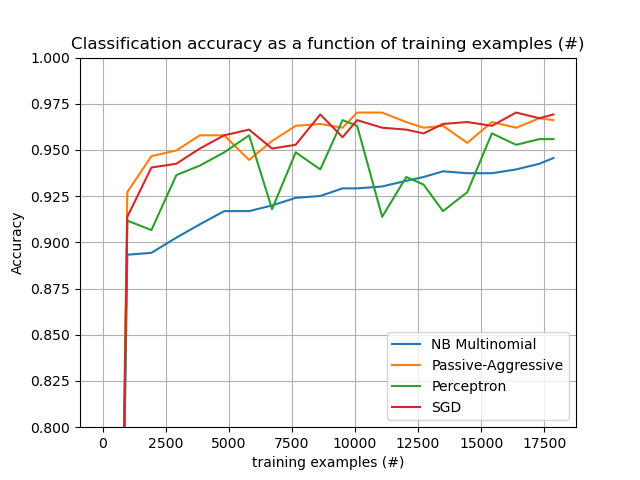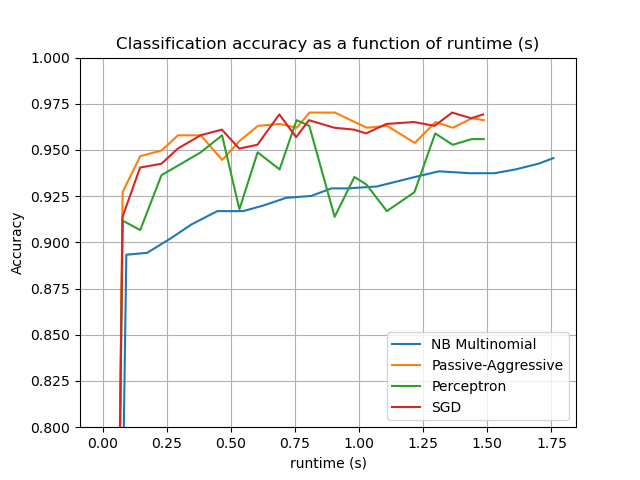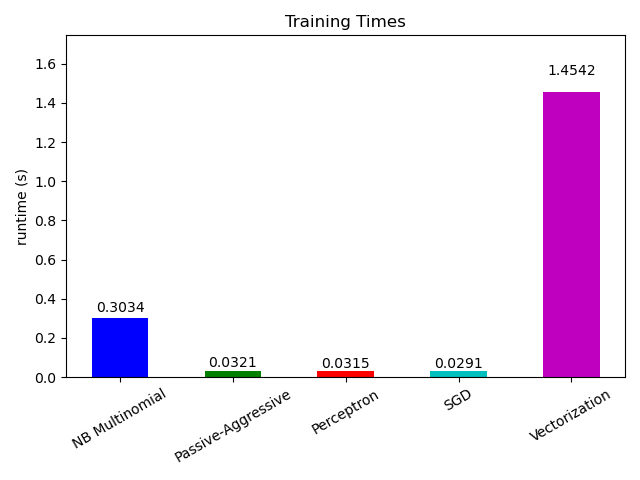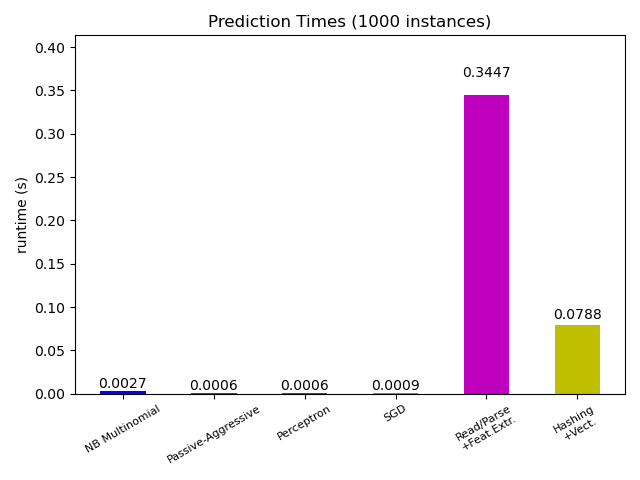Note
Click here to download the full example code or to run this example in your browser via Binder
Out-of-core classification of text documents¶
This is an example showing how scikit-learn can be used for classification using an out-of-core approach: learning from data that doesn’t fit into main memory. We make use of an online classifier, i.e., one that supports the partial_fit method, that will be fed with batches of examples. To guarantee that the features space remains the same over time we leverage a HashingVectorizer that will project each example into the same feature space. This is especially useful in the case of text classification where new features (words) may appear in each batch.
# Authors: Eustache Diemert <eustache@diemert.fr>
# @FedericoV <https://github.com/FedericoV/>
# License: BSD 3 clause
from glob import glob
import itertools
import os.path
import re
import tarfile
import time
import sys
import numpy as np
import matplotlib.pyplot as plt
from matplotlib import rcParams
from html.parser import HTMLParser
from urllib.request import urlretrieve
from sklearn.datasets import get_data_home
from sklearn.feature_extraction.text import HashingVectorizer
from sklearn.linear_model import SGDClassifier
from sklearn.linear_model import PassiveAggressiveClassifier
from sklearn.linear_model import Perceptron
from sklearn.naive_bayes import MultinomialNB
def _not_in_sphinx():
# Hack to detect whether we are running by the sphinx builder
return '__file__' in globals()
Main¶
Create the vectorizer and limit the number of features to a reasonable maximum
vectorizer = HashingVectorizer(decode_error='ignore', n_features=2 ** 18,
alternate_sign=False)
# Iterator over parsed Reuters SGML files.
data_stream = stream_reuters_documents()
# We learn a binary classification between the "acq" class and all the others.
# "acq" was chosen as it is more or less evenly distributed in the Reuters
# files. For other datasets, one should take care of creating a test set with
# a realistic portion of positive instances.
all_classes = np.array([0, 1])
positive_class = 'acq'
# Here are some classifiers that support the `partial_fit` method
partial_fit_classifiers = {
'SGD': SGDClassifier(max_iter=5),
'Perceptron': Perceptron(),
'NB Multinomial': MultinomialNB(alpha=0.01),
'Passive-Aggressive': PassiveAggressiveClassifier(),
}
def get_minibatch(doc_iter, size, pos_class=positive_class):
"""Extract a minibatch of examples, return a tuple X_text, y.
Note: size is before excluding invalid docs with no topics assigned.
"""
data = [('{title}\n\n{body}'.format(**doc), pos_class in doc['topics'])
for doc in itertools.islice(doc_iter, size)
if doc['topics']]
if not len(data):
return np.asarray([], dtype=int), np.asarray([], dtype=int)
X_text, y = zip(*data)
return X_text, np.asarray(y, dtype=int)
def iter_minibatches(doc_iter, minibatch_size):
"""Generator of minibatches."""
X_text, y = get_minibatch(doc_iter, minibatch_size)
while len(X_text):
yield X_text, y
X_text, y = get_minibatch(doc_iter, minibatch_size)
# test data statistics
test_stats = {'n_test': 0, 'n_test_pos': 0}
# First we hold out a number of examples to estimate accuracy
n_test_documents = 1000
tick = time.time()
X_test_text, y_test = get_minibatch(data_stream, 1000)
parsing_time = time.time() - tick
tick = time.time()
X_test = vectorizer.transform(X_test_text)
vectorizing_time = time.time() - tick
test_stats['n_test'] += len(y_test)
test_stats['n_test_pos'] += sum(y_test)
print("Test set is %d documents (%d positive)" % (len(y_test), sum(y_test)))
def progress(cls_name, stats):
"""Report progress information, return a string."""
duration = time.time() - stats['t0']
s = "%20s classifier : \t" % cls_name
s += "%(n_train)6d train docs (%(n_train_pos)6d positive) " % stats
s += "%(n_test)6d test docs (%(n_test_pos)6d positive) " % test_stats
s += "accuracy: %(accuracy).3f " % stats
s += "in %.2fs (%5d docs/s)" % (duration, stats['n_train'] / duration)
return s
cls_stats = {}
for cls_name in partial_fit_classifiers:
stats = {'n_train': 0, 'n_train_pos': 0,
'accuracy': 0.0, 'accuracy_history': [(0, 0)], 't0': time.time(),
'runtime_history': [(0, 0)], 'total_fit_time': 0.0}
cls_stats[cls_name] = stats
get_minibatch(data_stream, n_test_documents)
# Discard test set
# We will feed the classifier with mini-batches of 1000 documents; this means
# we have at most 1000 docs in memory at any time. The smaller the document
# batch, the bigger the relative overhead of the partial fit methods.
minibatch_size = 1000
# Create the data_stream that parses Reuters SGML files and iterates on
# documents as a stream.
minibatch_iterators = iter_minibatches(data_stream, minibatch_size)
total_vect_time = 0.0
# Main loop : iterate on mini-batches of examples
for i, (X_train_text, y_train) in enumerate(minibatch_iterators):
tick = time.time()
X_train = vectorizer.transform(X_train_text)
total_vect_time += time.time() - tick
for cls_name, cls in partial_fit_classifiers.items():
tick = time.time()
# update estimator with examples in the current mini-batch
cls.partial_fit(X_train, y_train, classes=all_classes)
# accumulate test accuracy stats
cls_stats[cls_name]['total_fit_time'] += time.time() - tick
cls_stats[cls_name]['n_train'] += X_train.shape[0]
cls_stats[cls_name]['n_train_pos'] += sum(y_train)
tick = time.time()
cls_stats[cls_name]['accuracy'] = cls.score(X_test, y_test)
cls_stats[cls_name]['prediction_time'] = time.time() - tick
acc_history = (cls_stats[cls_name]['accuracy'],
cls_stats[cls_name]['n_train'])
cls_stats[cls_name]['accuracy_history'].append(acc_history)
run_history = (cls_stats[cls_name]['accuracy'],
total_vect_time + cls_stats[cls_name]['total_fit_time'])
cls_stats[cls_name]['runtime_history'].append(run_history)
if i % 3 == 0:
print(progress(cls_name, cls_stats[cls_name]))
if i % 3 == 0:
print('\n')
Out:
Test set is 975 documents (104 positive)
SGD classifier : 981 train docs ( 125 positive) 975 test docs ( 104 positive) accuracy: 0.914 in 0.76s ( 1292 docs/s)
Perceptron classifier : 981 train docs ( 125 positive) 975 test docs ( 104 positive) accuracy: 0.912 in 0.76s ( 1287 docs/s)
NB Multinomial classifier : 981 train docs ( 125 positive) 975 test docs ( 104 positive) accuracy: 0.893 in 0.78s ( 1256 docs/s)
Passive-Aggressive classifier : 981 train docs ( 125 positive) 975 test docs ( 104 positive) accuracy: 0.927 in 0.78s ( 1251 docs/s)
SGD classifier : 3851 train docs ( 445 positive) 975 test docs ( 104 positive) accuracy: 0.951 in 2.17s ( 1774 docs/s)
Perceptron classifier : 3851 train docs ( 445 positive) 975 test docs ( 104 positive) accuracy: 0.942 in 2.17s ( 1772 docs/s)
NB Multinomial classifier : 3851 train docs ( 445 positive) 975 test docs ( 104 positive) accuracy: 0.910 in 2.19s ( 1757 docs/s)
Passive-Aggressive classifier : 3851 train docs ( 445 positive) 975 test docs ( 104 positive) accuracy: 0.958 in 2.19s ( 1755 docs/s)
SGD classifier : 6715 train docs ( 811 positive) 975 test docs ( 104 positive) accuracy: 0.951 in 3.50s ( 1917 docs/s)
Perceptron classifier : 6715 train docs ( 811 positive) 975 test docs ( 104 positive) accuracy: 0.918 in 3.50s ( 1916 docs/s)
NB Multinomial classifier : 6715 train docs ( 811 positive) 975 test docs ( 104 positive) accuracy: 0.920 in 3.52s ( 1907 docs/s)
Passive-Aggressive classifier : 6715 train docs ( 811 positive) 975 test docs ( 104 positive) accuracy: 0.955 in 3.52s ( 1905 docs/s)
SGD classifier : 9509 train docs ( 1093 positive) 975 test docs ( 104 positive) accuracy: 0.957 in 4.81s ( 1975 docs/s)
Perceptron classifier : 9509 train docs ( 1093 positive) 975 test docs ( 104 positive) accuracy: 0.966 in 4.82s ( 1974 docs/s)
NB Multinomial classifier : 9509 train docs ( 1093 positive) 975 test docs ( 104 positive) accuracy: 0.929 in 4.83s ( 1967 docs/s)
Passive-Aggressive classifier : 9509 train docs ( 1093 positive) 975 test docs ( 104 positive) accuracy: 0.962 in 4.84s ( 1966 docs/s)
SGD classifier : 12031 train docs ( 1396 positive) 975 test docs ( 104 positive) accuracy: 0.961 in 6.15s ( 1957 docs/s)
Perceptron classifier : 12031 train docs ( 1396 positive) 975 test docs ( 104 positive) accuracy: 0.935 in 6.15s ( 1956 docs/s)
NB Multinomial classifier : 12031 train docs ( 1396 positive) 975 test docs ( 104 positive) accuracy: 0.933 in 6.17s ( 1951 docs/s)
Passive-Aggressive classifier : 12031 train docs ( 1396 positive) 975 test docs ( 104 positive) accuracy: 0.965 in 6.17s ( 1950 docs/s)
SGD classifier : 14450 train docs ( 1738 positive) 975 test docs ( 104 positive) accuracy: 0.965 in 7.43s ( 1945 docs/s)
Perceptron classifier : 14450 train docs ( 1738 positive) 975 test docs ( 104 positive) accuracy: 0.927 in 7.43s ( 1944 docs/s)
NB Multinomial classifier : 14450 train docs ( 1738 positive) 975 test docs ( 104 positive) accuracy: 0.937 in 7.45s ( 1940 docs/s)
Passive-Aggressive classifier : 14450 train docs ( 1738 positive) 975 test docs ( 104 positive) accuracy: 0.954 in 7.45s ( 1939 docs/s)
SGD classifier : 17306 train docs ( 2163 positive) 975 test docs ( 104 positive) accuracy: 0.967 in 8.77s ( 1973 docs/s)
Perceptron classifier : 17306 train docs ( 2163 positive) 975 test docs ( 104 positive) accuracy: 0.956 in 8.77s ( 1972 docs/s)
NB Multinomial classifier : 17306 train docs ( 2163 positive) 975 test docs ( 104 positive) accuracy: 0.943 in 8.79s ( 1968 docs/s)
Passive-Aggressive classifier : 17306 train docs ( 2163 positive) 975 test docs ( 104 positive) accuracy: 0.967 in 8.79s ( 1968 docs/s)
Plot results¶
The plot represents the learning curve of the classifier: the evolution of classification accuracy over the course of the mini-batches. Accuracy is measured on the first 1000 samples, held out as a validation set.
To limit the memory consumption, we queue examples up to a fixed amount before feeding them to the learner.
def plot_accuracy(x, y, x_legend):
"""Plot accuracy as a function of x."""
x = np.array(x)
y = np.array(y)
plt.title('Classification accuracy as a function of %s' % x_legend)
plt.xlabel('%s' % x_legend)
plt.ylabel('Accuracy')
plt.grid(True)
plt.plot(x, y)
rcParams['legend.fontsize'] = 10
cls_names = list(sorted(cls_stats.keys()))
# Plot accuracy evolution
plt.figure()
for _, stats in sorted(cls_stats.items()):
# Plot accuracy evolution with #examples
accuracy, n_examples = zip(*stats['accuracy_history'])
plot_accuracy(n_examples, accuracy, "training examples (#)")
ax = plt.gca()
ax.set_ylim((0.8, 1))
plt.legend(cls_names, loc='best')
plt.figure()
for _, stats in sorted(cls_stats.items()):
# Plot accuracy evolution with runtime
accuracy, runtime = zip(*stats['runtime_history'])
plot_accuracy(runtime, accuracy, 'runtime (s)')
ax = plt.gca()
ax.set_ylim((0.8, 1))
plt.legend(cls_names, loc='best')
# Plot fitting times
plt.figure()
fig = plt.gcf()
cls_runtime = [stats['total_fit_time']
for cls_name, stats in sorted(cls_stats.items())]
cls_runtime.append(total_vect_time)
cls_names.append('Vectorization')
bar_colors = ['b', 'g', 'r', 'c', 'm', 'y']
ax = plt.subplot(111)
rectangles = plt.bar(range(len(cls_names)), cls_runtime, width=0.5,
color=bar_colors)
ax.set_xticks(np.linspace(0, len(cls_names) - 1, len(cls_names)))
ax.set_xticklabels(cls_names, fontsize=10)
ymax = max(cls_runtime) * 1.2
ax.set_ylim((0, ymax))
ax.set_ylabel('runtime (s)')
ax.set_title('Training Times')
def autolabel(rectangles):
"""attach some text vi autolabel on rectangles."""
for rect in rectangles:
height = rect.get_height()
ax.text(rect.get_x() + rect.get_width() / 2.,
1.05 * height, '%.4f' % height,
ha='center', va='bottom')
plt.setp(plt.xticks()[1], rotation=30)
autolabel(rectangles)
plt.tight_layout()
plt.show()
# Plot prediction times
plt.figure()
cls_runtime = []
cls_names = list(sorted(cls_stats.keys()))
for cls_name, stats in sorted(cls_stats.items()):
cls_runtime.append(stats['prediction_time'])
cls_runtime.append(parsing_time)
cls_names.append('Read/Parse\n+Feat.Extr.')
cls_runtime.append(vectorizing_time)
cls_names.append('Hashing\n+Vect.')
ax = plt.subplot(111)
rectangles = plt.bar(range(len(cls_names)), cls_runtime, width=0.5,
color=bar_colors)
ax.set_xticks(np.linspace(0, len(cls_names) - 1, len(cls_names)))
ax.set_xticklabels(cls_names, fontsize=8)
plt.setp(plt.xticks()[1], rotation=30)
ymax = max(cls_runtime) * 1.2
ax.set_ylim((0, ymax))
ax.set_ylabel('runtime (s)')
ax.set_title('Prediction Times (%d instances)' % n_test_documents)
autolabel(rectangles)
plt.tight_layout()
plt.show()
Total running time of the script: ( 0 minutes 9.873 seconds)




